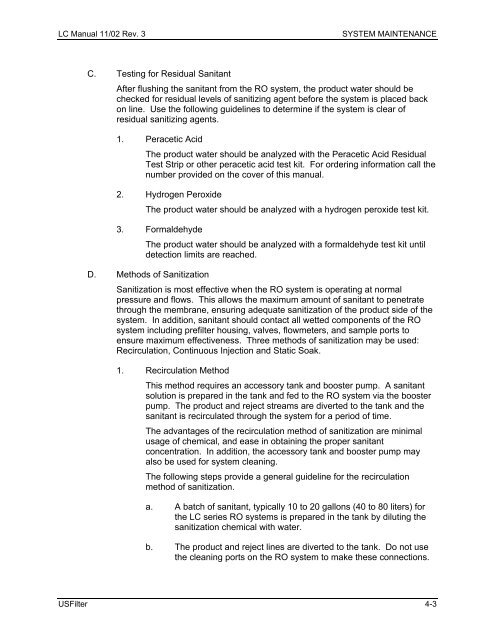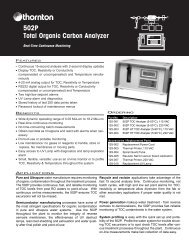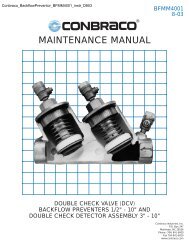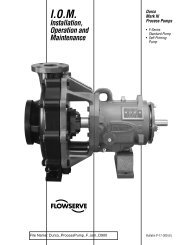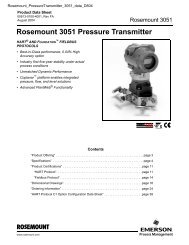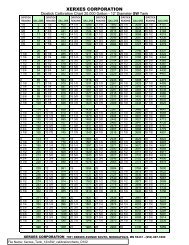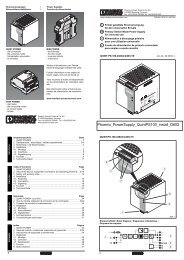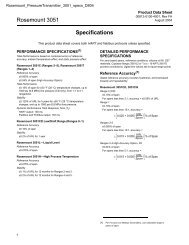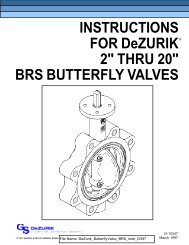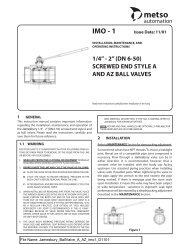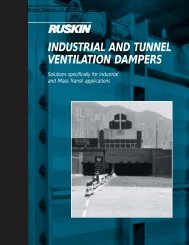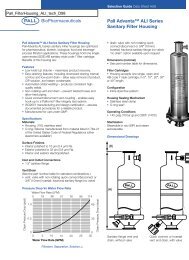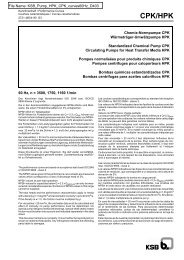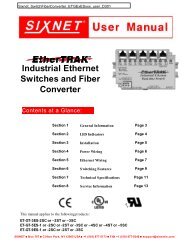Operation and Maintenance Manual for
Operation and Maintenance Manual for
Operation and Maintenance Manual for
Create successful ePaper yourself
Turn your PDF publications into a flip-book with our unique Google optimized e-Paper software.
LC <strong>Manual</strong> 11/02 Rev. 3 SYSTEM MAINTENANCE<br />
C. Testing <strong>for</strong> Residual Sanitant<br />
After flushing the sanitant from the RO system, the product water should be<br />
checked <strong>for</strong> residual levels of sanitizing agent be<strong>for</strong>e the system is placed back<br />
on line. Use the following guidelines to determine if the system is clear of<br />
residual sanitizing agents.<br />
1. Peracetic Acid<br />
The product water should be analyzed with the Peracetic Acid Residual<br />
Test Strip or other peracetic acid test kit. For ordering in<strong>for</strong>mation call the<br />
number provided on the cover of this manual.<br />
2. Hydrogen Peroxide<br />
The product water should be analyzed with a hydrogen peroxide test kit.<br />
3. Formaldehyde<br />
The product water should be analyzed with a <strong>for</strong>maldehyde test kit until<br />
detection limits are reached.<br />
D. Methods of Sanitization<br />
Sanitization is most effective when the RO system is operating at normal<br />
pressure <strong>and</strong> flows. This allows the maximum amount of sanitant to penetrate<br />
through the membrane, ensuring adequate sanitization of the product side of the<br />
system. In addition, sanitant should contact all wetted components of the RO<br />
system including prefilter housing, valves, flowmeters, <strong>and</strong> sample ports to<br />
ensure maximum effectiveness. Three methods of sanitization may be used:<br />
Recirculation, Continuous Injection <strong>and</strong> Static Soak.<br />
1. Recirculation Method<br />
This method requires an accessory tank <strong>and</strong> booster pump. A sanitant<br />
solution is prepared in the tank <strong>and</strong> fed to the RO system via the booster<br />
pump. The product <strong>and</strong> reject streams are diverted to the tank <strong>and</strong> the<br />
sanitant is recirculated through the system <strong>for</strong> a period of time.<br />
The advantages of the recirculation method of sanitization are minimal<br />
usage of chemical, <strong>and</strong> ease in obtaining the proper sanitant<br />
concentration. In addition, the accessory tank <strong>and</strong> booster pump may<br />
also be used <strong>for</strong> system cleaning.<br />
The following steps provide a general guideline <strong>for</strong> the recirculation<br />
method of sanitization.<br />
a. A batch of sanitant, typically 10 to 20 gallons (40 to 80 liters) <strong>for</strong><br />
the LC series RO systems is prepared in the tank by diluting the<br />
sanitization chemical with water.<br />
b. The product <strong>and</strong> reject lines are diverted to the tank. Do not use<br />
the cleaning ports on the RO system to make these connections.<br />
USFilter 4-3


